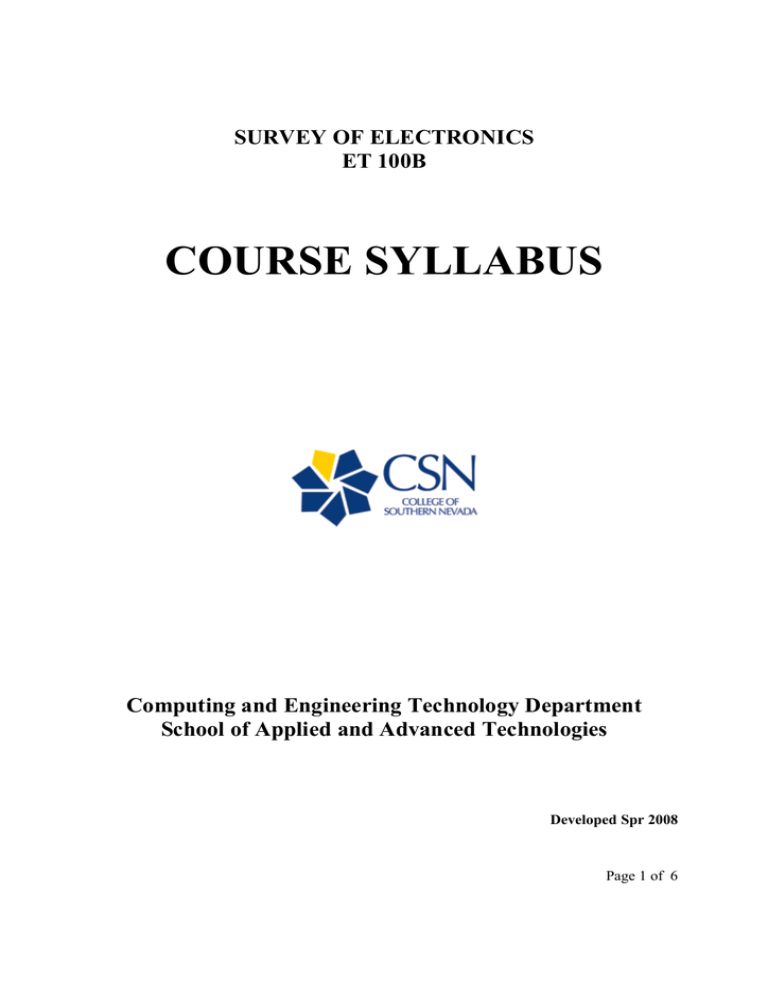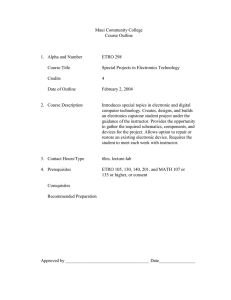course syllabus - Computer Graphics Home
advertisement

SURVEY OF ELECTRONICS ET 100B COURSE SYLLABUS Computing and Engineering Technology Department School of Applied and Advanced Technologies Developed Spr 2008 Page 1 of 6 COURSE NUMBER: ET 100B COURSE TITLE: Survey of Electronics SECTIONs: WC801, 6:00 - 8:50 PM Thursday & 001 9:00-11:50 AM Satuday CREDITS: 3 (3,0,0,0) PREREQUISITES: None SEMESTER: Spring, 2009 INSTRUCTOR: Joe Miller OFFICE NUMBER: CY2713 PHONE: 651- 4157 WEB: http://sites.csn.edu/jmiller OFFICE HOURS: Per schedule on Web Site E-Mail:joseph_miller@csn.edu TEXT: Various class and WEB site handouts OTHER REQUIRED MATERIALS: Scientific calculator COURSE DESCRIPTION: This course provides is an introduction to modern electronics technology through the process of building, testing and programming a simple robot. Topics covered are such fundamental concepts such as voltage, current, resistance, power, frequency, the functional analysis of simple analog and digital circuits and systems, micro-controllers, and controller programming. It introduces the student to standard electronic symbols, devices, and test instruments commonly used in the electronics industry. The role of the electronics technician is portrayed. Typical responsibilities and tasks that the electronics technician encounters in industry are covered. SAFETY: The electronics technician works with electrical and electronic devices. Test instruments are used to measure the electrical characteristics of these components and their respective circuits. There are many tasks that are involved with the technicians work. Even though these tasks are interesting and challenging, they may involve certain hazards if the technician is careless concerning work habits. It is essential that every student learn and practice the principles of safety. "The primary safety rule for general shop and the electronics laboratory is: THINK BEFORE YOU ACT - DON'T CLOWN AROUND! Safety is everyone's responsibility. Everyone must cooperate to create the safest possible working conditions." GENERAL LABORATORY SAFETY PROCEDURES: NO SMOKING in the building - Nevada State Law. Keep desks and work benches in a neat and orderly fashion. Page 2 of 6 Extraneous items of jewelry should be removed before applying power to a circuit. This includes ALL rings and ALL watches. No food or beverages will be allowed near work stations or machines. Keep aisles clear. Keep doors and drawers closed after obtaining necessary materials. Inspect the work station for safety hazards. Inspect test leads and hook-up wires for cuts, nicks, and exposed wire. Inform the instructor or lab assistant of any hazards that are found. Your instructor will inform you of additional safety rules that must be adhered to. ELECTROSTATIC DISCHARGE (ESD): ESD is a problem all technicians and engineers must be made aware of. All bench work will be accomplished at ESD protected work stations. DISABILITIES: If you have a documented Disability that may require assistance, you will need to contact the Disability Resource Center (DRC) for coordination of your Academic Accommodations. The Disability Center determines eligibility for and authorizes the provision of services. Campus Disability Resource Centers: Cheyenne: 651-4045 Charleston: 651-5089 Henderson: 651-3086 For those students that would like to earn a little extra cash, stop by the DRC to fill out a job interest card. This office hires students as note takers, proctors, scribes, and research assistants as needed. GRADING SCALE: A: 90 - 100%, B: 80 - 89%, C: 70 - 79%, D: 60 - 69%, F: <60% GRADING POLICY: Quizzes: 20%, Midterm: 40%, Final Exam: 40% The Midterm and final will occur on the scheduled days. Then quizzes will be given at random times as determined by the instructor. The quizzes can be either in-class tests or take-home tests. Page 3 of 6 Attendance Policy: College enrollment assumes maturity and seriousness of purpose. Students are expected to attend each meeting of every course for which they have registered. A student may be administratively dropped from a course for excessive absences upon recommendation of the course instructor and written approval of the Assistant Dean. Under no circumstances will an absence, for any reason, excuse the student from completing all work assigned in a given course. After an absence, it is the students responsibility to check with the instructor about completion of missed assignments. Course Content: 1. DC Concepts: Voltage, current, resistance, conductors and insulators, energy concepts, Kirchhoff’s Laws, series circuits, parallel circuits, series-parallel circuits, measurement of voltage, current, and resistance. 2. Inductance and Capacitance: Magnetism, inductance, capacitance, generators and motors. 3. AC Concepts: Alternation voltage and current, the sine wave: peak, average, and effective values, phasors, complex numbers, series and parallel resonance. 4. Semiconductor Devices: The PN junction, diodes, transistors, integrated circuits. 5. Electronic Circuits: Amplifiers, oscillators, power supplies. 6. Digital Circuits: Number systems: hexadecimal, octal, binary, logic gates, truth tables, flip-flops, counters, registers. 7. Digital Computers: Mainframe computers, microprocessors, microcomputers. COURSE OUTCOMES: 1. Understand DC circuit concepts. 2. Understand inductance and capacitance. 3. Understand AC circuit concepts. 4. Become familiar with the operation of semiconductor devices. 5. Understand digital circuits and number systems. 6. Understand micro-controllers and their programming METHODS OF EVALUATION COURSE OUTCOMES: 1. Examinations 2. Quizzes Page 4 of 6 WEEKLY TOPIC AND HOMEWORK SCHEDULE: Week 20 Jan 2008 Subject Introductions and Lecture: Overview of Electronics 26 Setting up your Micro-controller, parallel and series resistors, capacitors, and inductors 2 Feb 9 16 23 2 Mar 9 Description Introductions, History of Electronics, Jobs in Electronics, Common components and tools Software setup, hardware setup and testing, and ASCII code, identifying resistor, cap, & inductor values, their characteristics when in serial and parallel connections Servo-Motors and Bread-boarding rules, Ohm’s supporting Law, current flow, simple electronics concepts circuits, and motors Servo-Motors and Time measurement using supporting engineering units, connecting electronics concepts the servo-motors, centering them, and testing them Build the Boe Bot Servo-motor controls, pulsed and supporting signals, frequency of the pulses, electronics concepts pulse width, and period of the signals Building the Boe Continued building of the Boe Bot, low power Bot, introduction of analog sensors, and sound signal generation, and visual generation and auditory indicators Building the Boe Servo speed verses pulse with Bot, of the control signals. Other types of motor controls, ie, slot machine reel stepper motors Mid-Term Assignments Read on-line articles listed in lecture slides and per learning Module for Week 2 Per Week-3 Learning Module Per Week-4 Learning Module Per Week-5 Learning Module Per Week-6 Learning Module Per Week-7 Learning Module Study for the Mid-Term Page 5 of 6 Week 23 30 6 Apr 13 20 27 4 May 11 Subject Navigation and micro-controller memory Sensors Description Basic Boe Bot maneuvers & turning, calculating distances, and semiconductor memory Overview of sensors used in electronics and on robots Touch Sensors Micro switches and other touch sensors, reading the inputs and reacting Light Sensitive Photo resistors & transistors, sensors and RC & Building photo resistor test RL time constants circuits, charging and discharging reactive components in a RC or RL circuit, and testing 1-bit analog to digital converter Boe Bot Navigation Roam and avoid shadows test using photo and Roaming towards the light resistors test of the Boe Bot Infrared (IR) light Infrared (IR) light and the and object detection electromagnetic spectrum, IR using IR object detection and distance determination using IR, testing IR object detection and distance determination Boe Bot IR Boe Bot navigation using IR Navigation object detection/avoidance and navigation using IR distance determination Final Assignments Per Week-10 Learning Module Per Week-11 Learning Module Per Week-12 Learning Module Per Week-13 Learning Module Per Week-14 Learning Module Per Week-15 Learning Module Study for the Final Page 6 of 6


